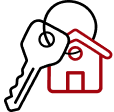Understanding Notice of Default: How to Respond to a Default Notice
KEY TAKEAWAYS
- A notice of default is the first official step in the foreclosure process due to missed payments, but it doesn’t necessarily mean losing your home.
- The default notice acts as a formal warning, allowing the homeowner the chance to address and rectify the situation.
- Upon receiving a notice of default, homeowners should immediately contact their lender, explore refinancing options, and consider seeking legal counsel.
- Ignoring the notice of default can escalate to foreclosure, impacting your credit score and potentially leading to further financial complications.



 Outstanding Client Experience
Outstanding Client Experience Specialized Lending Solutions
Specialized Lending Solutions Direct-to-Consumer Advantage
Direct-to-Consumer Advantage We're Advisors, NOT Salespeople
We're Advisors, NOT Salespeople Effortless Digital Mortgage Platform
Effortless Digital Mortgage Platform
Homeownership is a significant investment. Like all major financial commitments, you’ll have several responsibilities when you own a home, primarily keeping up with mortgage payments. Due to unforeseen circumstances, such as job loss, medical emergencies, or other financial hardships, homeowners may struggle to make timely mortgage payments.
In these situations, they might encounter terms like “notice of default (NOD)” or receive one of these notifications in the mail. A default notice is a notification a borrower might receive when they fail to meet their loan terms, marking the beginning of the foreclosure process.
However, receiving a notice of default doesn’t necessarily mean losing your home. Understanding what this notice means can help you take control and navigate away from foreclosure. Keep reading to learn more about what a notice of default is, what it means, and what you can do if you receive one.
KEY TAKEAWAYS
- A notice of default is the first official step in the foreclosure process due to missed payments, but it doesn’t necessarily mean losing your home.
- The default notice acts as a formal warning, allowing the homeowner the chance to address and rectify the situation.
- Upon receiving a notice of default, homeowners should immediately contact their lender, explore refinancing options, and consider seeking legal counsel.
- Ignoring the notice of default can escalate to foreclosure, impacting your credit score and potentially leading to further financial complications.
What Is a Notice of Default?
A notice of default in real estate is a formal document a lender issues when a borrower fails to fulfill the mortgage terms, especially when missing consecutive payments. Essentially, this document is the first formal step in the foreclosure process, warning the borrower that they’re at risk of losing their property if they don’t rectify the situation.
The default notice explicitly details the amount due, including penalties, and provides a specific period within which the borrower can clear the outstanding balance to prevent further action.
A notice of default is a public record registered with your local property records office, communicating that the lender has notified the borrower of their intent to pursue foreclosure. However, before a homeowner receives a NOD, they usually miss several mortgage payments consecutively. Lenders must make multiple attempts to communicate with the borrower before resulting in this more formal step.
For homeowners, receiving this notification signals the urgency to settle their outstanding payments, negotiate with the lender, or seek legal and financial counsel to explore available options.
What Is Included in a Notice of Default?
A notice of default is detailed to ensure the homeowner fully understands the severity of their situation and the steps required to remedy it. The typical components of a default notice include the following:
- Borrower’s information, which identifies the homeowner by their full name and address
- Property description, including its legal description and address
- Total amount overdue, including missed payments, penalties, late fees, and accrued interest
- Mortgage details, such as the loan number, origination date, lender’s name, and original loan amount
- Default description, including specifics about the nature of the default—whether it’s due to missed payments, failure to maintain property insurance, or any other violations of the loan agreement
- Timeframe given to cure the default by settling the amount due
- Instructions for remedying the default, such as how to pay, where to pay, and who to contact to discuss the default notice
- Consequences of not remedying the default, stating that if the borrower fails to rectify the issue within the given timeframe, the lender has the right to begin the foreclosure process and sell the property to recover the amount owed
Understanding these elements is crucial for homeowners because it can provide guidelines for rectifying the urgent situation. Having instructions ensures homeowners can act quickly without confusion, recognize the consequences, and negotiate terms or seek other avenues.

What Should You Do After Receiving a Notice of Default?
Receiving a notice of default can be alarming for homeowners because it signals missed mortgage payments and the initial steps toward foreclosure. However, it’s essential to understand that the distribution of a NOD doesn’t mean the foreclosure process is irreversible.
Here are steps you can take after receiving a NOD:
- Contact your lender: Reach out to your lending institution as soon as possible. They might offer solutions or arrangements to help you navigate the situation, such as loan modification, forbearance, or a repayment plan.
- Seek legal counsel: Depending on your situation, it may be beneficial to consult with a real estate attorney who specializes in foreclosures. They can guide you through your rights and potential courses of action.
- Explore your options: Your options to avoid foreclosure may include refinancing, selling the property, or considering a deed instead of foreclosure. To determine the best course of action, talk to your lender.
- Pay off your balance: The best thing you can do to avoid foreclosure is to pay off your balance. If you can find a way to pay the delinquent amount, you can immediately stop the foreclosure process.
While knowing what to do if you receive a default notice is crucial, you should also know what to avoid. You should never ignore a notice of default because this is the first step of the foreclosure process, which means potentially losing your property.
If you neglect your NOD, the lender can demand the entire loan balance rather than just the missed payments. This will also force them to begin foreclosure proceedings without you.
Ultimately, a foreclosure can hurt your credit score and lead to the loss of your home, and in some states, you may be responsible for paying the difference if the sale of your home doesn’t cover the entire mortgage debt.
How to Avoid Default Notices & Foreclosure
Receiving a NOD is stressful, but there are steps you can take to avoid it completely, including:
- Prioritize your mortgage: Treat your mortgage payment as the most critical monthly expense you have because it keeps a roof over your head. Ensure it’s the first thing you pay every month before any other bills and expenses.
- Establish an emergency fund: Financial experts recommend having at least three to six months’ worth of living expenses saved, which can be a lifeline if you face sudden financial difficulties.
- Stay informed: Keep track of your mortgage terms, interest rates, and any potential adjustments, especially if you have an adjustable-rate mortgage (ARM). If you plan to refinance, it’s also important to know your loan limit to reduce the risk of additional financial strain.
- Review your finances: Regularly assess your financial situation and adjust your budget to ensure you always have the means to cover your monthly mortgage payment. You should also review your mortgage statements regularly to check your outstanding balance, interest charges, and additional fees.
- Contact your lender early: If you experience financial difficulties, contact your lender. They might offer programs or solutions to assist borrowers facing temporary hardships. If you have a VA loan and took advantage of your VA loan guaranty to secure your mortgage, the VA may have additional resources for you.
- Consider refinancing: If interest rates have dropped since you took out your mortgage loan or your credit has improved, you might qualify for a lower monthly payment with a recent credit event non-qm loan.
Beware of Mortgage Default Notices
The process leading up to a mortgage default notice can cause anxiety and uncertainty. However, when armed with a proactive approach, homeowners can face these challenges with confidence. By prioritizing mortgage payments, staying connected with your lender, and seeking professional guidance, borrowers can reduce risks and protect their most valuable asset—their home.
If you’re looking for tools to optimize your financial wellness so that you can stay on top of your mortgage payments, check out the Griffin Gold app. The Griffin Gold app provides you with access to budgeting tools, useful calculator, and professional mortgage help and advice. Download the Griffin Gold app today to take control of your finances.
Griffin Funding is committed to empowering homeowners with the tools, resources, and support needed to ensure financial stability and peace of mind. Whether you’re looking to refinance, get a mortgage, or need advice, we’re here to guide you every step of the way. Apply for a mortgage loan online today.
Find the best loan for you. Reach out today!
Get StartedFrequently Asked Questions
Does a notice of default affect your credit score? 
Is a default notice serious? 
How soon can I expect foreclosure after receiving a notice of default? 
Recent Posts
Net Operating Income: Definition, Formula, & Examples
What Is Net Operating Income (NOI)? Net operating income measures how much money your investment property gene...
Best DSCR Lenders: Griffin Funding vs Angel Oak vs Kiavi vs Visio vs Lima One vs Easy Street
What to Look for in a DSCR Lender Choosing the best DSCR lender for your unique situation means evaluating sev...
Cash on Cash Return in Real Estate: Definition, Formula, & Examples
What Is Cash on Cash Return? Cash on cash return (CoC) is a metric that measures the annual income you generat...









